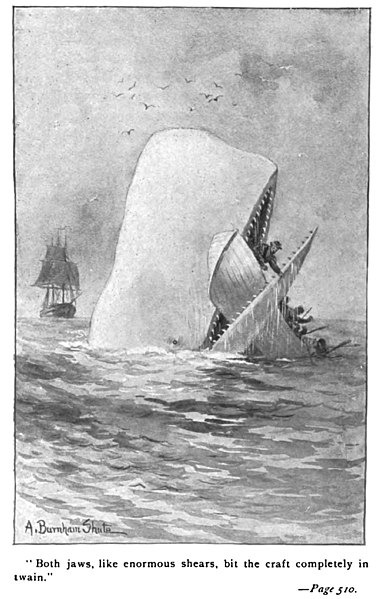Each week, culture intern Katherine will scour great works of literature for all the cheesy details your English teacher never showed you. Authors often include mentions of food and drink in their written works to give the reader a small glimpse into the culture and historic foodways of a particular place and era. This blog series will lend readers a helping hand and shed some light on the cheeses between the lines of the literary greats. Also, each week you’ll have a chance to win a special issue of culture magazine. Last week’s winner was Sharon!

Photos from Library of Congress and Penguin
Loathed by high school students throughout the nation and adored by swarthy sailors the world over, Herman Melville’s Moby Dick is an American classic that centers on the whaling industry in early 19th century New England. But for a book about whales, ships, and salty sailors, Moby Dick sure includes a lot of food in general and cheese in particular. Put on your sea legs and get ready to dive in… When we first meet the main character and narrator of the novel — a young former merchant marine named Ishmael — we learn that he has a few guidelines for choosing his sailing assignments and never volunteers to be the ship’s cook:
“…though I confess there is considerable glory in that, a cook being a sort of officer on ship-board— yet, somehow, I never fancied broiling fowls;—though once broiled, judiciously buttered, and judgmatically salted and peppered, there is no one who will speak more respectfully, not to say reverentially, of a broiled fowl than I will.”
Clearly, Melville and his characters are a bit obsessed with food. In addition to the numerous paragraphs concerning breakfast, lunch, and dinner — each and every one written in great detail— Melville utilizes food metaphors and food-related adjectives to describe other less-gastronomic scenes throughout the book. For instance, when Ishmael reels in the whaling line after a recent excursion he explains its magnitude in terms of cheese:
“Towards the stern of the boat [the whaling line] is spirally coiled away in the tub, not like the worm-pipe of a still though, but so as to form one round, cheese-shaped mass of densely bedded ‘sheaves,’ or layers of concentric spiralizations, without any hollow but the ‘heart,’ or minute vertical tube formed at the axis of the cheese. “
Either Ishmael really likes his cheese or Melville knew enough about the stuff to reference its characteristics and creation in everyday situations. Thanks to a thorough account of Melville’s personal history, we can assuredly claim the latter. Melville was indeed quite wise about cheese thanks to members of his own family. Although he was born in Manhattan, New York City, Melville and his family moved north to Albany and made a new life in the Hudson River Valley, the birthplace of many 19th century New England cheeses. Melville’s father worked as a merchant, importing fine goods from Europe and France. While an exact record of the elder Melville’s imports is unavailable, it is probable that fine French cheeses listed among them. With these two sources of cheese-related information, Melville’s use of dairy inspired vocabulary doesn’t seem too strange.

Photo from New York History Blog
Another example of Melville’s cheesy descriptions occurs when Ishmael and his fellow sailors finally capture a whale and collect their winnings in the form of precious ambergris.
“Dropping his spade, he thrust both hands in, and drew out handfuls of something that looked like ripe Windsor soap, or rich mottled old cheese; very unctuous and savory withal. You might easily dent it with your thumb; it is of a hue between yellow and ash color. And this, good friends, is ambergris, worth a gold guinea an ounce to any druggist.”
In addition to other parts of the whale, whaling ships and their sailors often collected ambergris, a solidified secretion found in the digestive tracts of sperm whales. Used for myriad applications, chiefly as a way to make perfumes last longer, ambergris could fetch a pretty penny depending upon its size and quality. But if you had to ask Melville, he might say that a “rich mottled old cheese” was a better prize.

Photo of ambergris by Ken Wilman
Melville uses cheese as a metaphor one last time to describe the sea surrounding Ishmael’s ship, the Pequod, during a nasty bout with a pack of fierce Atlantic sharks:
“To be sure, any man unaccustomed to such sights, to have looked over [the Pequod’s] side that night, would have almost thought the whole round sea was one huge cheese, and those sharks the maggots in it.”
In New England, the cheesemaking process is very similar to those used in England (where colonists first learned the art). But once the colonists arrived on American soil, cheesemakers found that a climate distinctly different from that of their native England, and the hot, moist atmosphere often caused their cheeses to mold (in the bad way) and grow maggots. In order to combat these issues, American versions of English cheeses were often coated with an impregnable substance (like animal fat). Even with a minimal knowledge of cheese, Melville would have undoubtedly known this characteristic of New England cheeses and probably experienced maggoty cheese firsthand on one of his own sailing adventures through the Atlantic.

Photo by Library of Congress
With a bit of close reading we’ve discovered that Melville used his prior cheese knowledge and the cheese-filled lineage of his Dutch ancestors to describe certain scenes throughout his novel. To top this all off, Melville scatters mentions of real-world cheeses throughout the book that allude to various aspects of the whaling industry and his own experiences. Two cheeses in particular stand out from the rest.

Photos from Life’s Little Adventures and Wezenspyk
When Ishmael finds an old book with a “musty whaling smell” filled with the accounts of an “ancient Greenland and Spitzbergen whale fishery,” he lingers over the ship’s rations, which included:
“2,800 firkins of butter.
20,000 lbs. Texel & Leyden cheese.
144,000 lbs. cheese (probably an inferior article).”
We can assume that Melville either encountered these popular cheeses on one of his many sailing trips or consumed them in his own home thanks to the influence of his Dutch mother and grandfather. With a little extra sleuthing we learn that these cheeses are alive and well and still available through many specialty cheesemongers. The first cheese mentioned, the Texel, comes from a small sheep-covered island of the same name belonging to the Netherlands. With alternate spellings like Tessel and Texele this old-world style cheese is a little hard to find. Modern day versions of the cheese, which are still made according to traditional methods, weigh between five and six kilos (or about 11 to 13 pounds), age for a minimum of six months, and have a “lingering elemental flavor that tastes of animal musk and the sea” (see the Slow Food Foundation for a full description).

Photo from Grafton Village Cheese
The second cheese, called Leyden or Leidse kaas, is a bit easier to source and is a popular cheese throughout the Netherlands. Made with cow’s milk, Leyden is a round, flat cheese with a yellow color and spiced throughout with cumin seeds. Both of these cheeses are of the drier, firmer variety and would have been perfect choice for long, refrigerator-less sea voyages. With enough cheese rations to last the trip, these Dutch sailors would be able to combat the cold arctic waters with a layer of fatty insulation as they searched the seas for whales and other winnings. As the cook in Moby Dick says, “Grub, ho!”

Photo from Moby-Dick edition – C. H. Simonds Co
So do you think you have what it takes to be a sailor aboard a whaling ship in the 19th century? Keep in mind that Melville’s descriptions of cheese rations is very real, the scary white whale, not so much.
WIN AN ISSUE OF CULTURE
Leave a comment below (please use an email address we can contact you at if you win!) telling us about your favorite seafood and cheese pairing by 11:59 p.m. EST, Monday, October 14, 2013 for a chance to win a copy of culture: the word on cheese‘s 101 Best Cheeses of the Year; one winner will be chosen at random from all commenters. At the end of the blog series, we will choose one lucky commenter to win a gift package including a year’s subscription to culture, a copy of our special 101 Best Cheeses of the Year issue, and a literary cheese from this series.




